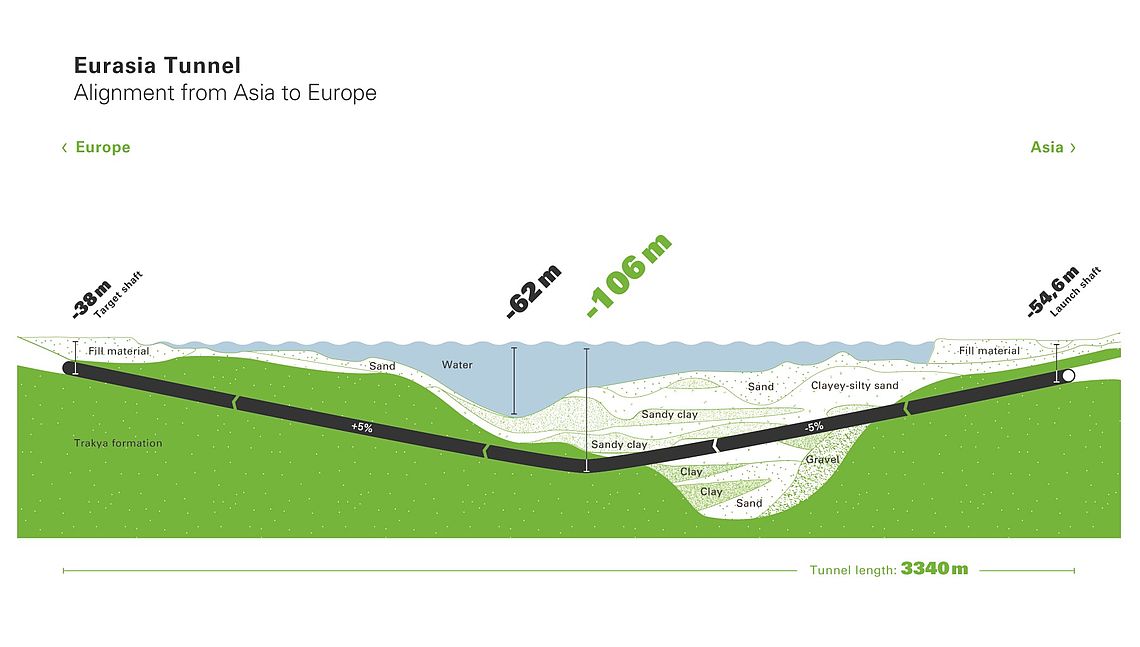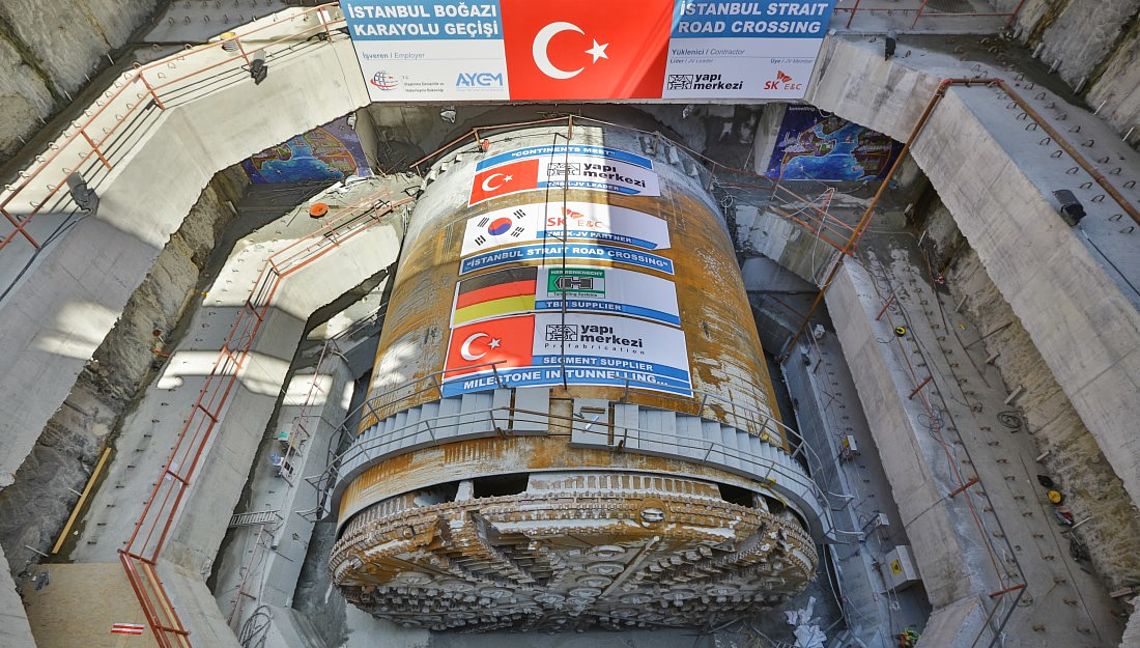The route of the "Istanbul Strait Road Tube Crossing Project" runs around 100 meters below sea level at its deepest point. There the water pressure is about 11 bar: eleven times atmospheric pressure. Never before has such a large, high-performance tunnel been built underground under such complex and extreme conditions. The interior diameter of the tunnel is 12 meters so that two lanes in each direction can be accommodated. They extend one above the other on two levels. To avoid obstructing ship traffic the tunnel was dug with a specially designed tunnel boring machine (TBM). 3.34 kilometers of the first road tunnel between the Asian and European parts of Istanbul, with a total length of 5.4 kilometers, were created by a Herrenknecht Mixshield.
The sheer size of the tube did not make construction easier. But only with this diameter can the Eurasia Tunnel fulfill its task: accommodating several ten thousand cars a day. A figure that has far-reaching consequences for traffic in the city. Commuters from the south in particular, who had to take the chronically congested First Bosporus Bridge in the center so far, can cross to the other side directly now. In rush hour that can shorten the travel time of many from up to 100 minutes down to 15.
The more northerly Fatih Sultan Mehmet Bridge, the second traffic bottleneck between the continents, is also relieved. According to plan the tube helps to get the slow-moving traffic in the 18-million metropolis flowing again. A circumstance that has a further advantage in addition to a huge time saving for the three million Bosporus commuters: a significant reduction in CO2 emissions in the city.

Eurasia Tunnel: At its deepest point the tunnel alignment of the Istanbul Strait Road Tube Crossing Project runs more than 100 meters below the surface of the strait. Inclinations of up to 5% were overcome.
Tunnelling in the heterogeneous geology was conduced with a TBM type Mixshield. The Mixshield technology allows an advance of 8 to 10 meters in 24 hours even in the extremely challenging environment under the Bosporus. The cutting wheel was equipped with different tools for all eventualities: large cutting knives scratched softer subsoil from the tunnel face, from where – combined with a water-clay mixture – it was flushed through a hydraulic slurry circuit to the separation plant in the launch shaft.
When the machine encountered harder solid rock, the 35 twin disc cutters did most of the work. The 19-inch discs, weighing 1 tonne each including the cutterbox, were pressed against the tunnel face by the displacement cylinders of the cutting wheel drive and rolled off it. Individual pieces, so-called chips, broke out of the rock. Smaller pieces were sucked through an intake screen and removed by the flushing cycle. The rest was crushed by a jaw crusher in front of the screen which – like a powerful hydraulic nutcracker – crumbles even large boulders effortlessly. At the same time, the hydraulic circuit was used for building up and regulating the so-called face support pressure against the water and ground pressure of the Bosporus. A principle developed further by Herrenknecht that has proven itself worldwide countless times.
With Herrenknecht we had a partner on board we can trust completely.
Başar Arıoğlu, chairman of Yapı Merkezi Bane NOR
To detect strong material wear early and to tackle necessary maintenance accesses in a targeted manner, wear detectors were integrated into the excavation tools as well as in the steel construction of the cutting wheel. Moreover, the disc cutters were equipped with the DCRM system (Disc Cutter Rotation Monitoring) which was developed by Herrenknecht. It provides data about the rotational movement and temperature of the disc cutters in real time to the machine operator in the control container. Thus, conclusions can be drawn regarding the condition of the tools and change intervals can be better planned.
Project Facts
According to the extensive geological and hydrogeological preliminary investigations, tunnel builders had to reckon with water pressures of up to 11 bar along the tunnel alignment. To be able to change the excavation tools quickly and safely even with high pressures, Herrenknecht developed an innovative cutting wheel concept. "The particular challenge was to develop a cutting wheel that allows safe replacement of the excavation tools from the inside even with the huge external pressure," explains Werner Burger, Head of Engineering at Herrenknecht.
The result: a cutting wheel accessible from the rear through narrow working chambers. The tools could thus be changed safely by the crew through special lock systems under atmospheric pressure conditions. Thanks to this cutting wheel innovation, time- and cost-consuming access for maintenance work under pressurized air could be reduced. In addition, the Mixshield was equipped with a special, newly developed lock system. It allowed pressurized air access at well over 5 bar where necessary.
The tunnelling for the "epoch-making project" was launched on the Asian shore of the strait in April 2014. With pioneering technology and an ideal cooperation of all project partners the TBM accomplished best performances of up to 92 meters per week under the Bosporus. After only 16 months the Mixshield pierced the target shaft wall on the European side exactly to plan on August 22, 2015.
"State-of-the-art technology is one of many puzzle pieces. More decisive, however, was our unshakeable willpower and mutual trust in each other. Only through these have we jointly achieved the breakthrough in this exceptional project," Martin Herrenknecht emphasized. "Being here today is like a dream come true for me," added Yapı Merkezi Chairman Başar Arıoğlu proudly at the breakthrough ceremony.
The successfully completed drive marks new feasibility standards in tunnel construction. The new tunnel infrastructure is the first direct link between the historic Golden Horn peninsula on the European side and the port area on the Asian side. In Istanbul the new road tunnel provides major relief of traffic congestion on the strait crossing. Since late 2016 several ten thousand cars a day are crossing between the continents in the Eurasia Tunnel.

After 16 months of tunnelling, on August 22, 2015 a tunnel boring machine from Herrenknecht successfully crossed under the Bosphorus.
| Column 0 | Column 1 |
|---|---|
Tunnelling Length |
3,340 m |
| Geology | Heterogeneous soils, 70 % Trakya Formation (mudstone, sandstone, volcanic rock and solid rock) and 20 % marine deposits (clay, silt, sand, gravel, boulders) |
| Client | Republic of Turkey Ministry of Transport, Maritime Affairs and Communications and General Directorate of Infrastructure Investments (AYGM) |
| Contractor | Yapı Merkezi İnşaat ve Sanayi A.Ş. (Leader) and SK Engineering & Construction Co. Ltd Joint Venture |
| Machine Data | 1x Mixshield: Diameter: 13,660 mm Lining method: Segmental lining Cutterhead power: 4,900 kW Torque: 23,290 kNm |
We are ready!